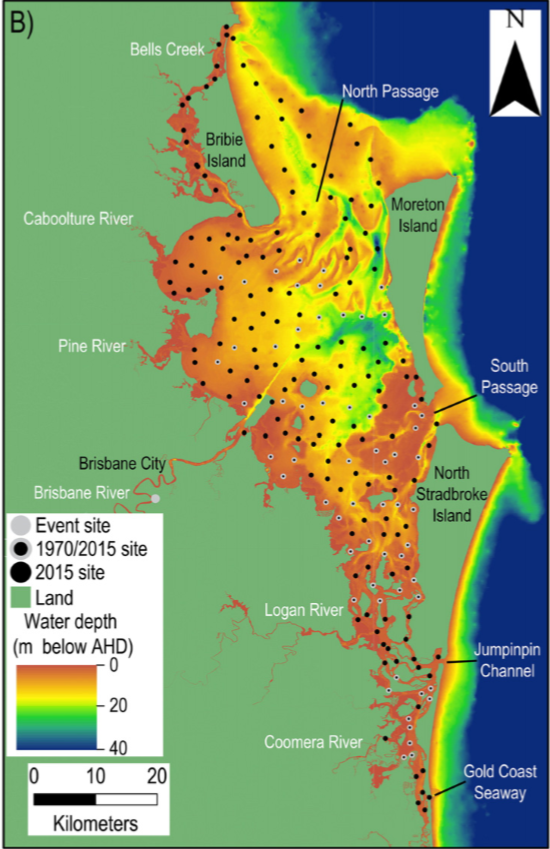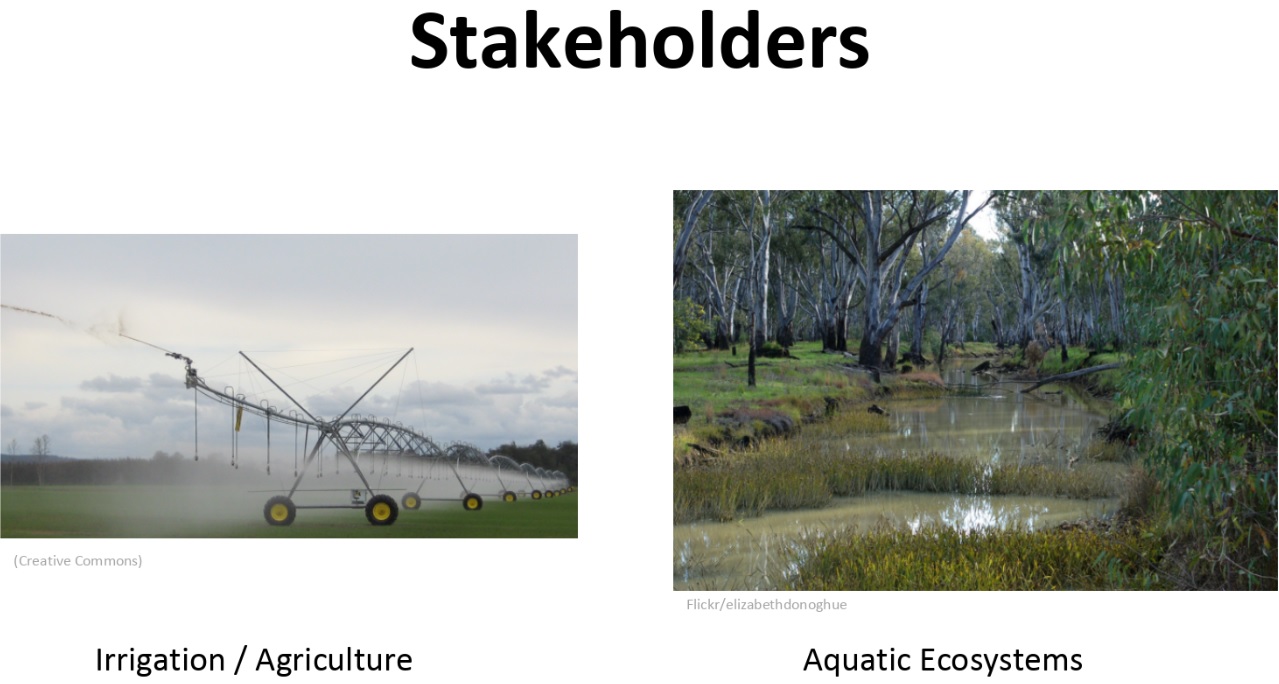
-
Hydrometry
Report
Environmental Technician
Environmental Manager/Owner
Australia
- 07 February 2024
- | Blog
Water in the cloud: Balancing irrigation vs. ecosystems water needs
Paper presented to the 18th Australian Hydrographers Association Conference Canberra, 24-27 October 2016.
Surface water in Queensland is a valuable resource that creates value for landholders when it is extracted and irrigated on crops, and for aquatic ecosystems when it is left in situ.
In Queensland, the Department of Resources (formerly the Department of Natural Resources, Mines & Energy or DNRM) is the agency responsible for balancing the conflicting water needs of these two stakeholders. Historically, this has been achieved by compromise, by limiting extraction to preserve environmental base flows.
There is growing scientific knowledge of the needs of aquatic ecosystems which indicates that the timing of flows is as important as the volume of flow (DNRM 2016).
This paper describes a method by which ecosystem flow needs can be managed using a combination of sensors and visual inspection, and allowing flows to be dynamically varied by applying complex rule systems discharged through a cloud platform to maximize the health outcomes for aquatic ecosystems without reducing the total water available for seasonal irrigation.
Introduction
We propose a method of allocating surface water to landholders and aquatic ecosystems (water stakeholders) to maximize the value gained from this fixed resource by both. The method involves dynamic variation of flows using the Internet of Things (IoT) and cloud computing.
The needs of these two water stakeholders (landholders and aquatic ecosystems) are in conflict. If unconstrained, landholders may seek to extract excess water for irrigation, to the detriment of aquatic ecosystem health. Conversely, to maximize the health of aquatic ecosystems, all extraction of water for irrigation would cease. This would be at the expense of a 12 billion dollar industry in Queensland (QGSO 2016).
In Queensland, the Department of Natural Resources and Mines (DNRM) is responsible for balancing the needs of industry and community for access to safe and reliable water supplies, restoring natural flow regimes to support high-value ecological assets1 and ecosystem functions. DNRM is restricted in its ability to manage ecosystems, specifically aquatic health through flow assessment only, using the application of rules on the capture and take of water by landholders (DNRM 2016).
1 Ecological assets are an ecosystem component that occurs naturally in the Water Resource Plan area, is critically linked to flow and is dependent on the conditions provided by flow to support its long-term integrity. It may be a species, a group of species, a biological function, an ecosystem or a place of natural value.
- Author: Ben Starr
- Read time: 3 mins
- Region/Location: Australia, Queensland
- Vertical: Coal Seam Gas
- Sectors: Oil & Gas
- Hardware: Campbell Scientific

This paper seeks to achieve the following:
- Review the historic method of balancing the positions of water stakeholders and highlighting some issues with this strategy.
- Outline the emerging scientific knowledge of specific flow needs of Ecological Assets, being produced as a result of directed research by the Queensland Government.
- Set out how sensors and cloud computing could be utilized to allow for dynamic variance of flow (by modifying the timing and rate of extraction, and releases from regulated creeks) to better meet the newly identified needs of aquatic ecosystems to maximize health outcomes with available water rations, all while not reducing allocations of water to landholders. A case study of the current use of a cloud system by DNRM Toowoomba is provided as a feasibility study.
Interests vs. positions
When considering the problem of balancing the needs of landholders and aquatic ecosystems to surface water access, it is useful to consider the conflict in a negotiation framework. Specifically, to identify the interests and positions of each party and the differences between them.
Interests and positions explained - what a party says they want in a negotiation is their position (both landholders and aquatic ecosystems want water), why each party wants it is their interest (landholders want water to help their crops grow, aquatic ecosystems want water to maximize their health). The differences between interests and positions are demonstrated by this short story.
There was once only one orange left in a kitchen and two prominent chefs were fighting over it when preparing a meal for visiting dignitaries.
“I need that orange!” One chef shouted.
“Yes, but I need that orange as well!”
They decided on a compromise, splitting the orange.
One chef squeezed the juice from the orange and poured it into the special sauce he was making. It wasn’t quite enough, but it would have to do. The other grated the peel and stirred the scrapings into the batter for his famous cake. He too didn’t have as much as he would have liked, but given the situation what else could he have done? Had both chefs understood why the other wanted the orange (their interest), and had not focused on their position of just wanting the orange (their position), both could have had their needs met completely. As it neither achieved a satisfactory result. Compromise in this and in all scenarios where interests are not understood results in shared value being neglected.
Landholders' position is that they need water. Their interest in water is for irrigation of crops to increase yield (or achieve growth). Water, rather than land, is the limiting factor for production in traditional agricultural systems. An increase in the availability and reliability of water can be expected to result in increased yield and profitability for farmers. Considering that Queensland's agricultural production has a value of approximately $9.2 billion, an increase in the availability of water yields a direct and quantitative financial benefit to farmers, and to Queensland more generally through food security, tax revenue, and lower-cost produce.
Their primary interest is the total volume available on a seasonal basis. The timing of extraction of waters is of low interest to landholders as they have largely invested in assets (ring tanks) that allow them to effectively buffer water demand.
Aquatic ecosystems also have the position that they need water, but their interests are more complex. They seek flows that maximize ecosystem health, including protection of instream and riparian habitats, stable creek morphology, flushing of nutrients, connectivity of pools, some disturbance to keep introduced species at bay, and cues for breeding behavior.
These needs vary between waterways and reaches within waterways depending on the factors limiting ecosystem health. To complicate issues, impacts on the health of aquatic ecosystems do not have the quantifiable economic marker that impacts to farm yields have, affecting comparisons of the equity of any negotiated outcome. Developing research indicates that aquatic ecosystems are very sensitive to the timing of flows, with certain flows (such as those that are required cues for spawning) yielding significantly greater health benefits, than say continued base flow.
The primary difference between the interests of the two parties is land users are less concerned about when water is able to be extracted due to the ability to buffer supply and demand with ring tanks, whereas ecosystems are much more concerned about when flows occur. This difference in interests forms a strong case for value creation.
Past flow management strategy
Past flow management strategies have been based largely on the compromise of positions of landholders and aquatic ecosystems, or cutting the orange in half.
The long-term extraction limits applied by the Queensland government are largely focused on preserving base flow and do not have a focus on identifying or addressing the dynamic flow needs of aquatic ecosystems.
These outcomes are achieved through the combined effect of the following rules contained in resource operation plans:
- Water sharing rules
- Infrastructure operating rules
- Flow event management rules
The long-term, integrated, rule-based approach that Queensland has taken means that there is limited opportunity for active management of flow to target the specific needs of environmental assets and ecosystem function at a more granular time frame (seasonal or flow-based).
As our understanding of the variable needs of these environmental assets grows, so will the need for dynamic water extraction regimes to match system hydrology with asset and ecosystem needs.
Understanding the needs of aquatic ecosystems
By understanding when flows create the most benefits for each specific ecosystem, and varying the total flow volume to maximize these benefits – aquatic health can be maximized without reducing the total volume available for agricultural applications.
To understand when environmental flows are (or are not) required in different ecosystems, some examples found in Resource Operations Plans and scientific studies are provided below.
- To manage the Narran Lakes Ramsar wetland site filling. Water harvesting entitlements are reduced to 90% of the daily entitlement, when a flow event occurs that would be sufficient to fill the lakes between 1 April – 31 August. Water allocations are reduced again if a subsequent ‘filling flow’ occurs within 4 months of this first event.
- Studies in the Condamine and Balone regions found that contrary to expectations, there was little evidence of a boom in the individual body condition of fish in response to floods, and the extent of floodplain inundation did not influence the food base or the energy transfer through food webs.
- Some native fish rely on high flows during winter and spring as cues to begin migration and spawning; without these seasonal high flows, breeding can be severely affected.
- Some species rely on combinations of water temperature and rises in water level as cues for spawning. The Golden Perch, which is one of the Keystone species in the Murray Darling system (DoE 2013) spawns following a rise in river height when the temperature is approximately 23oC. If river rises do not occur, spawning is delayed until the following season.
- Alterations in base flow rates in heavily regulated waterways (such as occurs at the base of the Murray River) can have impacts on flora and bank stability, causing the drowning of riparian vegetation and wetlands which are adapted to only temporary inundation.
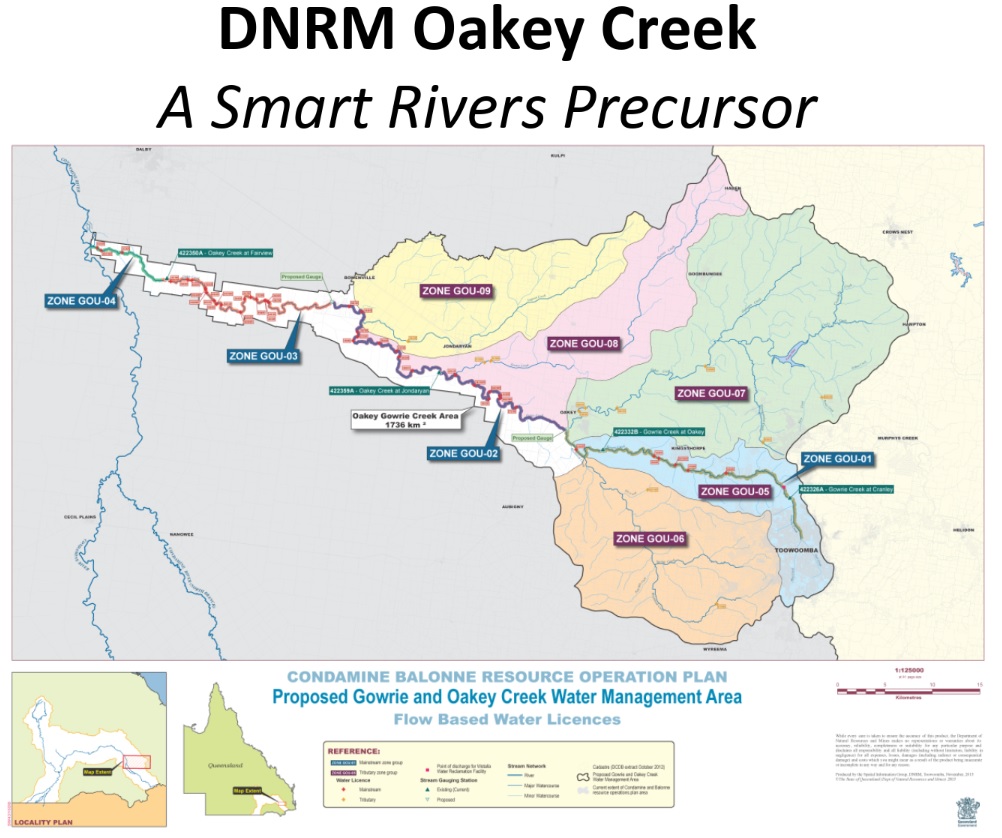
Implementation will require technology
Understanding the specific flow needs of aquatic ecosystems will be insufficient to achieve positive health outcomes for Ecological Assets. Active management will be required to allow detection of conditions when flows are needed or may be forgone without impact, and to administer increases or decreases in flow, ideally automatically. Flow management can be achieved by DNRM through flow releases in regulated waterways, or by temporarily limiting extraction by landholders.
To achieve active management, DNRM will need to make use of a system of real-time sensors to monitor the current status of waters, have a solution to ingest and analyze data from these sources to determine when environmental watering is required and to automate controls on flow.
The fundamental ingredients to deliver a completely automated solution are:
1. Sensors or monitoring to collect data on the needs of aquatic ecosystems, which may include:
- Height of water in wetlands
- Temperature of water
- Flows
- Breeding cycle or times (manual inspection)
- Trends in abundance of pest fish (manual sampling)
2. Cloud-connected gates on regulated creeks
3. A cloud platform that can:
- Ingest data that is needed to make a decision when extraction should occur
- Host decision-making rules developed as interests of ecosystems become better understood
4. Send instructions to pumps (allowing landholders to override these instructions when water is not wanted).
5. In the future, smart pumps (pumps connected by gateways), that are configured with a gateway to receive control instructions to provide a completely automated solution.
Case Study: DNRM use of cloud software
DNRM in Toowoomba is using a cloud-based platform to ingest flow data from five weirs in Oakey Creek and to automate the sending of notifications to 41 landholders with water extraction permits.
Currently, the notifications are based on simple rules; they are issued when flows at the nearest upstream weir of the landholder exceed a height nominated in their license, which permits them to start extraction. A second message is sent when flows drop below this height, notifying that extraction must stop.
Users can log in to the system to view real-time flows and take limits, as shown below.
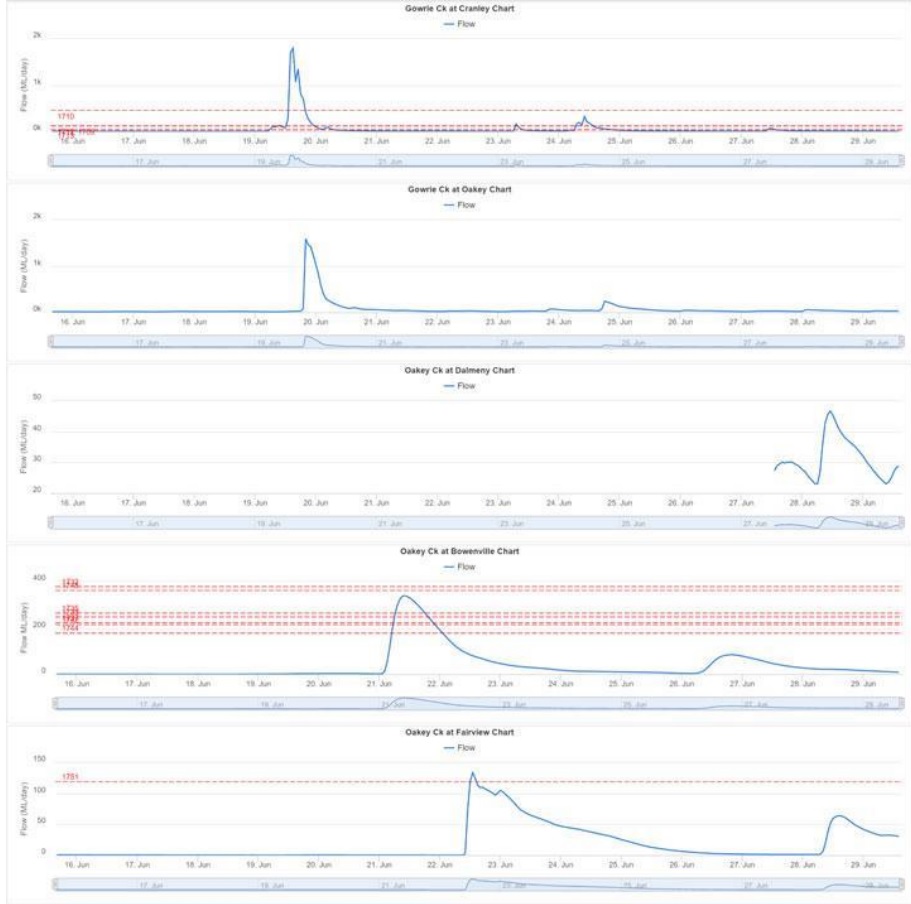
Dashboard showing flows and extraction triggers, Oakey Creek
Although the current system uses only simple rules for triggering extraction, a cloud software system such as the one employed by DNRM could allow for more complex rules to be applied based on real-time sensor data to match flow with ecosystem needs more closely. Examples of these dynamic systems include.
- Restriction on extraction based on antecedent flow conditions, such as those described for the Narran Lakes Ramsar site above.
- Restrictions on water extraction based on sensor data. This could be used to restrict extraction during the first flow event after the water temperature reaches 23oC to cue the spawning of Golden Perch in the Murray River.
- The system could also keep a tab on the water that was withheld for agricultural uses, and increase availability at times that did not yield strong environmental benefits.
- The system could be automated further if landholder pumps were connected via remote gateways to allow remote instructions. Either party could stop extraction; DNRM with automated rules to time environmental watering, and the landholder when they sought water. This final stage would allow a diverse range of assets owned by different parties to work in concert to achieve maximum value for both.
Conclusion
Compromise on flows by simply conserving baseflow in systems does not allocate flows in a way that maximizes ecosystem health.
An active management program that allows administrators to detect the needs of ecosystems for flow in near real-time, and respond to these needs dynamically by restricting extraction or releasing waters increases health without reducing the availability of flows for irrigation over an annual time scale.
The feasibility of implementing a dynamic flow control system such as this is being demonstrated with the DNRM application of cloud data monitoring and notification at Oakey Creek in Toowoomba.
Looking for cloud-based environmental monitoring? Contact eagle.io to request a demo.
Citations
- DoE. (2013). Threatened Species Scientific Committee’s Advice for the River Murray and associated wetlands, floodplains and groundwater systems, from the junction with the Darling River to the sea. Canberra: Threatened Species Scientific Committee.
- DNRM (2012) Environmental Flows Assessment Program. Queensland Department of Natural Resources and Mines, Brisbane.
- DNRM (2016) Queensland Annual Environmental Watering Priorities 2016-2017: Implementing the Murray-Darling Basin Plan. Queensland Department of Natural Resources and Mines, Brisbane.
- DPI (2016) Water flow. New South Wales Department of Primary Industries. http://www.dpi.nsw.gov.au/fishing/habitat/threats/water-flow Accessed 21/09/2016.
- QGSO (2016) Gross Value of production by commodity, Queensland, 2004-05 to 2014-15. Queensland Government Statistician's Office. Accessed 3/100/2016
- http://www.qgso.qld.gov.au/products/tables/agriculture-gross-value-production/index.php
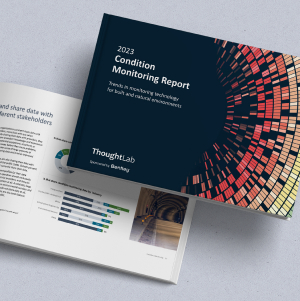
2023 Insights into Environmental Monitoring
Download nowDetails
- Author: Ben Starr
- Read time: 3 mins
- Region/Location: Australia, Queensland
- Vertical: Coal Seam Gas
- Sectors: Oil & Gas
- Hardware: Campbell Scientific



